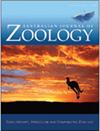新几内亚特有的毒蝇属(毒蝇亚目:毒蝇科)。有多少种?基于形态、分布和分子数据的分析
IF 1
4区 生物学
Q3 ZOOLOGY
引用次数: 0
摘要
摘要目前已知的有五种,即longicaudata, naso, habbema, melanurus和rothschild。形态学数据,包括前磨牙的间距,脚垫和外观的各个方面,以及来自每个物种范围内的多个样本的细胞核和线粒体DNA序列,表明其中至少有三个代表物种群体,而不是单个物种。在这5个物种中,一些目前同义的分类群可能需要恢复,包括M. murex, M. aspera, M. maxima。longicaudata '组,M. tafa在' M。naso组和M. wilhelmina组。melanurus”组。我们的数据还表明,在“longicaudata”、“naso”、“melanurus”和“habbema”种群中存在其他同义或未描述的分类群,其物种边界需要进一步的收集和研究来澄清。本文章由计算机程序翻译,如有差异,请以英文原文为准。
The endemic New Guinean genus Murexia (Dasyuromorphia : Dasyuridae). How many species? An analysis based on morphological, distributional and molecular data
Abstract. Five species are currently recognised in the dasyurid genus Murexia, i.e. longicaudata, naso, habbema, melanurus and rothschildi. Morphological data, including spacing of premolar teeth, the footpads and aspects of external appearance, together with nuclear and mitochondrial DNA sequences from multiple exemplars from across the range of each species, suggest that at least three of these represent species groups rather than individual species. Some of the taxa currently synonymised in the five species may warrant reinstatement, including M. murex, M. aspera, M. maxima in the ‘M. longicaudata’ group, M. tafa in the ‘M. naso’ group and M. wilhelmina in the ‘M. melanurus’ group. Our data also suggest the presence of other, synonymised or undescribed taxa within the ‘longicaudata’, ‘naso’, ‘melanurus’ and ‘habbema’ species groups whose species boundaries require clarification by further collections and study.
求助全文
通过发布文献求助,成功后即可免费获取论文全文。
去求助
来源期刊
CiteScore
2.40
自引率
0.00%
发文量
12
审稿时长
>12 weeks
期刊介绍:
Australian Journal of Zoology is an international journal publishing contributions on evolutionary, molecular and comparative zoology. The journal focuses on Australasian fauna but also includes high-quality research from any region that has broader practical or theoretical relevance or that demonstrates a conceptual advance to any aspect of zoology. Subject areas include, but are not limited to: anatomy, physiology, molecular biology, genetics, reproductive biology, developmental biology, parasitology, morphology, behaviour, ecology, zoogeography, systematics and evolution.
Australian Journal of Zoology is a valuable resource for professional zoologists, research scientists, resource managers, environmental consultants, students and amateurs interested in any aspect of the scientific study of animals.
Australian Journal of Zoology is published with the endorsement of the Commonwealth Scientific and Industrial Research Organisation (CSIRO) and the Australian Academy of Science.

 求助内容:
求助内容: 应助结果提醒方式:
应助结果提醒方式:


